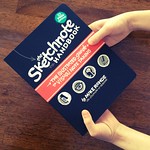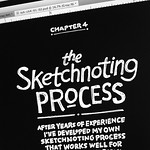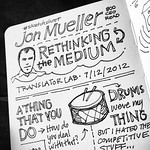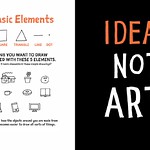[Review] The Sketchnote Handbook (Video Edition)
Who should read this?
Anyone who’s seen The Sketchnote Army and wished they could do that. Anyone who’s sick of useless meeting notes they never remember, and never go back to read. Anyone who wants a way to provide information to people in a way that people will actually enjoy consuming, and not just skim through.
The best laid plans…
My initial intent was to create this review in Sketchnote form, but Sketchnoting is, in no small part, the art of filtering essential ideas from a stream of words, and presenting them in a semi-visual fashion in order to help convey and emphasize the important points. The problem is that The Sketchnote Handbook has already done this. Every point I wanted to note was something Mike Rohde (the author) had already created a succinct Sketchnote about. To create an even remotely comprehensive review I’d have to draw out most of the book.
So, I’m left with words.
Some background
Most people know me as either a programmer, or an adventurer, but not many know that I occasionally do illustrations for folks too.
I ordered this book because I’ve been fascinated with Sketchnotes; their look, their personality, and their ability to convey the essential information from any event. Dachary and I have been pondering not just writing our next adventure but Sketchnoting it as well. If we can pull it off, the result would be an incredibly engaging way of keeping up with an adventure.
I’d seen plenty of Sketchnotes, and with a childhood spent in art classes the technical details of how they were created wasn’t a question. Anyone who applies any thought to the matter should be able to figure that out (text + related doodles equals sketchnote). From a technical perspective they’re pretty trivial. What’s been missing is information about the approach. How does one go about sketchnoting? How do you manage to keep up with a speaker? What is the process by which one chooses what things to emphasize, what layout to use, when to draw and when to write?
And that, is where, and why the Sketchnote Handbook excels.
The Book
By page 18 this book has addressed the common problem of people running around claiming “I can’t draw”. It does this, by conveying the simple fact that Sketchnotes are about “IDEAS NOT ART”, points out that everything can be drawn with 5 simple elements (Circle, Square, Triangle, Line, Dot), provides a handful of quickie examples, and then proceeds to do what every other Sketchnote resource should have done: moves on.
To me, that was the moment I realized “Holy crap! This book is actually going to be about Sketchnoting not ‘Stick Figures 101’.” And that’s what makes this book incredible. Seriously, this is an incredible book, and one you must buy if you have any interest in learning to create your own Sketchnotes.
What makes this incredible is that it’s about the process of Sketchnoting. It says “Hey, this is what Sketchnoting is. This is why it’s valuable. Here’s how to listen. Here’s how you make a Sketchnote. Here are common patterns, and approaches people take to making them.” Only then, once he’s given you everything you need (146 very quick pages in) does he go back to the “Stick Figures 101”, which is probably good, because drawing is a lot like singing. People are convinced they’re horrible at it, which leads to them not having the guts to try it and find out that that can be pretty decent at it if they would only give themselves permission to try.
Because the book is itself a Sketchnote, there’s no need to skim to “the important part”. It is exclusively important parts, and key concepts. While you don’t need to be an artist to create amazing Sketchnotes, Sketchnoting is itself an art form, and as such you can’t define it with explicit rules. There are core concepts, and basic techniques that are shared across all Sketchnotes, but like all art, there’s no “correct” way to do it. There are only guidelines that you may or may not choose to follow, and Mike’s done a wonderful job of conveying those, and showing how those concepts play out through examples from many talented Sketchnoters with diverse styles.
The Video Edition
The quality of the videos is quite good, even though, for the most part, you’re just watching Mike at a desk or literally looking over his shoulder as he’s drawing. But… I’m not full sold on them.
I think that, for the most part, the book does a better job of conveying the information. Much of the video feels like “Highlights from the book”, but there is definitely some additional value there. There’s a surprising difference between reading that he’ll bring a speaker’s photo up on his iPhone and seeing him holding the iPhone whilst propping up a corner of the notebook with the same hand and drawing with the other. Watching him draw even the simplest of visual elements like dividers and lines is somehow much more… accessible, and achievable, than seeing a static page of them. This is, I think, incredibly valuable for people who don’t have faith in their drawing ability.
The 9th video is the most important one in the series, because it’s just watching over Mike’s shoulder, in real time, while he Sketchnotes a talk. It’s fascinating to watch what information he chooses to incorporate, and what information gets left out, to see some things the speaker said earlier on enter the page a minute or two later, when you thought he was going to leave it out entirely.
I have to say though, I wasn’t thrilled with the way that most of the videos were edited down into two to three minute clips. To me that was more frustrating, because you’re not going to watch just one. You’re going to watch a swath of them, but you keep having to go back and click on the next one. I think it would have been much better served by breaking the 70 minutes of footage down into three of four sections.
If I had to do it again, knowing what I know now, would I buy the video edition? Yes, if only for the 9th video. If I was to recommend this to someone who wasn’t confident in their ability to doodle though I would absolutely recommend the video. It really helps to show that Sketchnoting is something that anyone can do.
With that said, I can’t recommend buying the “Video Edition” of the physical book. When you buy it there’s a stiff square insert in the back that looks like it contains a DVD. It doesn’t. There’s a pull-tab that reveals a code to the web site where you can watch the video on the Peachpit website, which feels like a total deception to me. There is, however, a “Multimedia DVD” edition which does come with a DVD. Buy that if you want the video, or get the regular version and go to Peachpit.com and pay for the video separately.
Summary
If you’re interested in trying you hand a sketchnoting, then buy this book ( or get it with the DVD).
Contest!
Yup. To all those lovely folks who’ve made it this far I offer you a simple contest. Draw me something that makes me smile. Ball point pen, watercolors, crayons, charcoal, whatever. Stick it online and tweet me a link. First one to make me smile wins a copy of the regular (sans video) edition.
[Update: Too late! I’ve been made to smile! Thanks for reading this far though. Now, go buy a copy. It’s worth every penny.]







